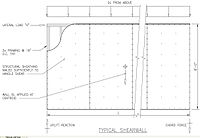
Photo from wikipedia
Abstract An experimental investigation was conducted to study the structural performance of concrete-timber composite beams provided with systems of semi-rigid connectors of various configurations and stiffness. Eleven concrete-timber composite beams… Click to show full abstract
Abstract An experimental investigation was conducted to study the structural performance of concrete-timber composite beams provided with systems of semi-rigid connectors of various configurations and stiffness. Eleven concrete-timber composite beams and one concrete-steel composite beam were tested in three-point flexure test. The construction of the beam web and the type of shear connector were the basic parameters of investigation. The feasibility of boosting the flexural performance of these beams when wrapping their webs with GFRP laminates was examined. Comparison of the flexural behavior of the proposed composite concrete-timber beams with that of both of post-stressed beams using external steel longitudinal rods and a concrete-steel composite beam was also evaluated. Test results showed that vertical glulam timber web is superior to both horizontal glulam and massive block timber webs in providing higher stiffness and load carrying capacity and larger toughness. Also, dovetail shear connector enhanced with insertion of a steel dowel at the center of the groove imparts a full composite action between concrete and timber web. Use of GFRP laminates wrapping along the full span of timber web is a highly effective method to take advantage of the use of enhanced dovetail shear connector. The behavior of the proposed concrete-timber composite beam was comparable to that of the concrete-steel web beam.
Journal Title: Ain Shams Engineering Journal
Year Published: 2018
Link to full text (if available)
Share on Social Media: Sign Up to like & get
recommendations!